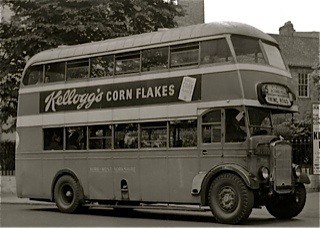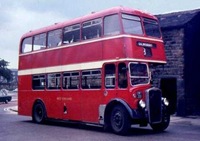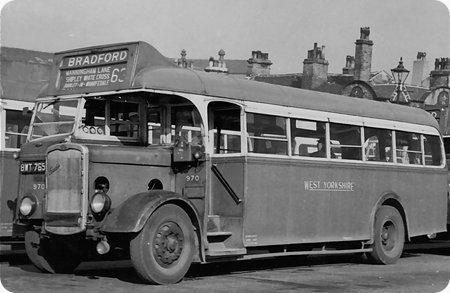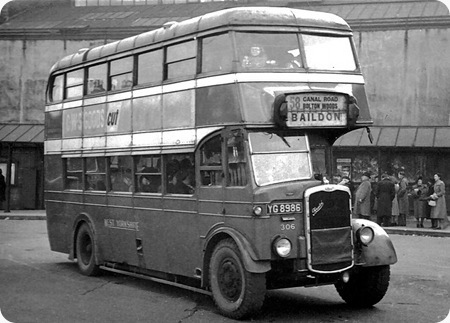West Yorkshire – Bristol K5G – OWT 201 – YDG 88
West Yorkshire Road Car Company
1954
Bristol K5G
ECW H28/28R
A fine vehicle indeed, but quite sad in some ways. This typical ex-Tilling Group Bristol K5G is spending its final days on loan to Yorkshire Woollen District, after its parent company (York-West Yorkshire) had lost its Tilling identity to the National Bus Company. 
Eleven Bristol K5Gs were added to the York – West Yorkshire fleet in 1939, being numbered Y395-9/Y701-6, and registered DWU 133-7/994-9, (706 is seen to the right here).
They gave sterling service, and will always be remembered by West Yorkshire fans as a contrast to the dominance of the post war style in the fleet, as they lasted in original form until 1954/5.
In 1954/5, they were taken out of service, and were to re-emerge with handsome new 4 bay ECW bodies as seen here. New chassis frames were used, but the running units were fully overhauled and re-fitted. Because new chassis frames were fitted, the rebuilt vehicles were re-registered OWT 195-205.
To cover their temporary absence, 3 most interesting vehicles were purchased from Brighton, Hove and District, and these would merit a post in themselves! They were 1931/2 AEC “Regents” which had “Gardner 5s”, and 1944 ECW highbridge bodies to the post war profile, being quite similar to the prototype body built the same year on a K5G for the Tilling Group. A ride on one of these vehicles was like being at a symphony concert…. melodies and harmonies from the gearbox and engine were beyond description, but a delight nevertheless. One could perhaps walk quicker than the top speed of these veterans, which were numbered ADG 1-3 in the new 1954 system!
To return to our rebuilt K5Gs, they re-entered service with YDG numbers in the new system mentioned above, and settled down to give another fine spell of service, before succumbing to the inevitable FS type Lodekka, and others.
The new numbers were YDG 82-92 and YDG 88 is seen in our main photograph above, which was taken by Bob at Dewsbury bus station in July 1969.
York-West Yorkshire was a truly wonderful fleet, and how lucky we West Yorkshire enthusiasts were to have these two “side fleets” of Keighley , and York, which both had their own character and contrast to the main fleet. Keighley, and the main fleet always used lowbridge double deckers, whereas York used the highbridge layout, and the flat terrain was ideal for the K5G. I can still hear them chugging sedately round that beautiful old city!
As always, when nostalgia kicks in, it is really difficult to grasp the passage of time, it now being well over 40 years since the demise of these buses. York never seems (quite) the same place these days, without the super old red and cream buses which were part of the character of the place!
Photograph Bob Gell, insert shot S J N White with copy by John Whitaker
A full list of Bristol codes can be seen here.
A full list of West Yorkshire fleet codes can be seen here.
———
13/03/11 – 10:38
Thank you, thank you, John, for your wonderful write-up that so faithfully reflects the spirit of the York-West Yorkshire fleet of my childhood and youth. I was brought up with the 1939 K5Gs; the photo of 706, with its original ‘bible’, (or ‘flap-board’), indicator is shown on route 6, regularly operated with these vehicles, as was service 2 between Stuart Road and Bur Dyke Avenue. I remember so well as a small boy waiting at our local bus stop with my mother, telling her the service number of the next bus to arrive – you could hear it before you saw it – by the sound of the engine. Sometimes you could even tell individual vehicles from their distinctive engine notes. The rebodying exercise resulted in these buses having a remarkable total life of almost 30 years with Y-WY. It did produce the cynical response amongst some York residents, however, that re-registering them was a bit of a con trick by the Joint Undertaking to disguise the vehicles’ true age.
In service the rebuilt vehicles tended, to be truthful, to lack performance, (were the new bodies heavier?), even on York’s relatively flat terrain. Y-WY had a policy of allocating Bristol and Gardner engined buses to different routes, but some routes might have either. I worked for Y-WY as a conductor in 1962 and 1963, and getting a YDG rather than a YDB or YDX was a sign that you could well end up running late at peak times.
You also mention the famous ADGs. I never came across them because my father worked abroad during their entire time with Y-WY, but I remember a driver on the Fulford Rota – they were mainly used on the 4/4A route – demonstrating to me in graphic and most amusing detail that they were the most unpleasant and unrewarding vehicles he ever drove. He said the pedals were very high while the gear lever was positioned low down and behind the driver, so that all gear changes required an act of contortion. He reckoned – as you say, ADGs were not noticeably quick – that a change from third to second was a lottery to be avoided at all costs, and claimed, (of course drivers were not always accurate in their interpretations of management decisions), that the reason the ADGs were usually allocated to the Fulford Rota was to reduce that eventuality by avoiding Holgate Hill.
Incidentally, they were never actually owned by Y-WY, despite having the name on the side, but were hired from WY.
Finally, the colour picture of YDG88 shows it with its later, T-shaped destination indicator. Originally, it had the full three-section indicator, which had five different blinds to set. When you were running late on Service 3/11, changing from 11A back to 3 at the terminus was a drag, especially if it was your last trip before being relieved and you had an impatient driver.
Thank you again, John. Happy days, indeed!
Roy Burke
———
13/03/11 – 10:46
I was very interested to see the photograph of West Yorkshire OWT 281. These were along with others initially hired from West Yorkshire and then taken in to the Yorkshire Woollen fleet during a vehicle shortage. I remember conducting these buses.
Philip Carlton
———
14/03/11 – 07:17
John W has said some wonderful things about York West Yorkshire and brought back many fond memories of my visits to York in the early fifties. West Yorkshire Road Car was in my view a quality ex Tilling Company and always produced some excellent rebuilt pre-war Bristol K5G buses from their Harrogate Works. The final York K5Gs were their last re-bodies to appear and were based again on a solid Bristol engineering and a Gardner 5LW.
Richard Fieldhouse
———
14/03/11 – 07:22
Roy’s last paragraph reminds me of the ultimate "pantomime" concerning the changing of multiple destination displays. When I was a West Yorkshire conductor at Ilkley we had a route to Heber’s Ghyll – five minutes each way and no recovery (standing) time. Single deckers were always used and had three piece displays front and rear, and always went straight onto other routes with differing information.
Chris Youhill
———
14/03/11 – 13:17
I am really pleased Roy, that you enjoyed the post about what are obviously favourite buses to us both! Thanks also for the ADG anecdotes.
I believe the OWT rebodies would be less lively than the originals, as they would, as you suggest, be heavier.
There really was something special and "ponderous" about YWY which was absolutely fascinating. We lived in Bradford, but passed through regularly on the way to Bridlington, and our weekend/holiday tram bungalow at Skipsea. Lucky you, living there. You must have plenty of WY experience to share with us!
John Whitaker
———
16/03/11 – 11:14
As you say, John, I had lots of pleasant and amusing experiences with York-West Yorkshire, which I’d happily share, except that much the same could be said of anyone who’s worked as a conductor with any operator. Two examples: Chris has shared his recollection of changing a blind in a hurry. Great fun, but I bet there are many readers of this site who have had the unnerving experience of changing a front blind as the driver reversed into a side road. I’ve done that many times, but I used to draw the line at the driver pulling forward again while I was still clinging on although jumping off as the driver did so was a real recipe for trouble!
Also, while I agree with you wholeheartedly about missing the red and cream buses, the atmosphere of York City itself has changed a great deal in the last half century; not for the better in my view, but that’s life. I recall, incidentally, a passenger who must then have been about the same age we are now telling me he remembered when the colour of the City’s buses was blue, so…..
Roy Burke
———
16/03/11 – 14:18
Hi Roy. I cannot remember the blue buses in York, but I do know what you mean!.
I was in York two Saturdays ago for a railway Museum visit, and I must admit it was a little too "Touristy" for my taste these days. Things change. Maybe we could share our photo collections a bit, as we probably both have gaps. Just a thought, and good to share happy memories with another enthusiast.
John Whitaker
———
23/03/11 – 17:55
As a boy the first time I really took any notice of buses was on a holiday to Bournemouth (late 60’s), looking out for KSW’s without a dented front or rear dome (there weren’t many) I thought the Green and Cream livery on the Hants and Dorset buses very smart until I noticed a Red and Cream Lodekka FLF belonging Wilts and Dorset, I liked the squarer profile of the K to the more rounded Lodekka. M y dad couldn’t understand why we had to go past the bus station each day, a great holiday and buses.
Roger Broughton
———
24/03/11 – 06:39
Hi, has anyone out there a West Yorkshire fleet list that I could have a copy of, as my own list is a very sketchy one?
Keith Easton
———
24/03/11 – 18:25
Hi Keith
Re. WYRC fleet list. I have the one in the old TPC book by Keith Jenkinson, but it is a bit sketchy, with no withdrawal dates. I could transcribe this over time, into acceptable format and put it forward for inclusion in the new fleet list section. There is, however, both a PSV Circle list, and a West Yorkshire Information Service (now defunct) list which gives a lot more detail, so before embarking on any such project, does any of our "fraternity" have one of these publications. I am afraid mine disappeared years ago, although I have taken extracts from PSVC one at the Omnibus Soc. archives.
If I go ahead with this, it will need someone else to take over after about 1956, when my interest begins to wane!
John Whitaker
———
25/03/11 – 08:16
Hi John, Thanks for the offer, but the TPC book is where my somewhat sketchy list came from! I have most details from the 1980’s, and the earlier ones would be most welcome, but perhaps wait until we see what, if anything, materialises. Once again thanks for your offer.
Keith Easton
———
09/05/11 – 08:11
After reading all the interesting comments above about the York fleet, I seemed to recall that at some point YWY had considered purchasing some second hand KSWs for the fleet. On looking through John F Gill’s fascinating and very informative book ‘York-West Yorkshire Joint Services – 50 Years of Joint Services 1934-1984’ again, this was confirmed. What surprised me though was the lateness of the year – 1967. At this time YWY was ordering new VR and RE buses for its 1968/9 deliveries, to replace the rebuilt K5Gs (including YDG 88 illustrated above) and two of the 1951 KS-types, which according to the book would have left eight YDBs in service, and that the JOC were considering purchasing eight 1954 KSWs from Bristol Omnibus to replace them! However, it was later decided not to pursue the matter, as the cost of bringing the vehicles up to standard would have been uneconomic. (The book states that the only Bristol Omnibus double deckers that fitted the date quoted would have been highbridge KSWs from the PHW/SHW-registered batches). Given the notorious reliability problems with the early VRTs though, maybe the JOC were on the right track after all!
Brendan Smith
———
10/05/11 – 07:26
I used to travel on united counties between Derngate and Earls Barton. The routes on A45 were mostly 402 and 404. K6A were normal, but 3 buses had 6 cyl engines 615 662 were 2 of them. in the morning it was 2 L5G single deckers every day. These had an overdrive gear engaged from 4th. it was only usable from about 40mph. occasionally the speed reached nearly 60 on the down hills, but how I wish they had the familiar [to me] Daimler gearboxes. the town buses were so different but i think all had Gardner 5s. I was at Barton turn one day and 4 corporation buses roared past where the K5s struggled.
P Bartlett
———
10/05/11 – 07:30
Brendan’s point about York-West Yorks looking at Bristol OC K types is interesting given that some of their own would have gone to Yorkshire Woollen in 1969 to a vehicle shortage there!
Chris Hough
———
 Vehicle reminder shot for this posting
Vehicle reminder shot for this posting
———
22/01/12 – 11:38
Having been away from from my computer for a while, I’ve only just seen this excellent posting, which for me – by co-incidence it’s now within a day or two of being exactly 50 years since I began working for York-West Yorkshire – has particular nostalgia. I remember these vehicles very well indeed, and must have worked on YDG88 many, many times.
The re-bodied 1939 K5Gs were probably the most unpopular vehicles in the Y-WY fleet – certainly amongst the crews, and in so far as they took any notice of the bus they were travelling on, with passengers too. As Richard F points out, they were noisy and and rough, both the ride and the engine note. The photo was, I believe, taken in Rougier Street, where the sound of anything pulling away with a full load and a 5LW engine reverberated loudly. Since there would often be an East Yorkshire Leyland passing through at the same time, the comparison was not flattering to Y-WY!
They were also slow, even in comparison with the re-bodied 1938 K5Gs, which I’ve always assumed, (others, better informed, might disabuse me of that notion), was due to their body weight. Some drivers would, for example, use first gear when pulling away from the traffic lights at the junction of Queen Street and Blossom Street with a full load, the only vehicles on which this ever happened. On the question of re-registering, Keith Jenkinson, in his highly informative book, ‘York City Buses’, says that the decision was taken at a meeting of the Joint Committee on 20 July 1954: ‘…as they would appear as "new" buses, it was agreed that they should be re-registered in order to reflect that.’ A popular explanation amongst the crews – I don’t vouch for its truthfulness – was that a City Councillor on the Joint Committee was facing re-election and was keen to get York some ‘new’ buses since there hadn’t been any since February 1952. Giving the vehicles new fleet numbers was just being consistent with new registration numbers.
One point has always baffled me and I’d be grateful for an explanation from someone. Some of these vehicles ended up with Yorkshire Woollen District to cover for that company’s vehicle shortage in, I think, 1969. My query is about the reasons for YWD’s shortage. All BET companies had a vehicle replacement programme, so what caused the shortage?
Roy Burke
Quick links to the - Comments Page - Contact Page - Home Page



